De la sèrie Districte 5è, cap a 1960, Joan Colom Altemir
This text focuses on the best-known body of work by Joan Colom (1921-2017), the photographs he took in Barcelona's Barrio Chino between 1957 and 1960. The reason why these photographs are so well known is because a selection of them was published by the Lumen publishing company shortly afterwards, in 1964, in a book that formed part of the collection Palabra e Imagen (Word and Image).
As is often the case with photography, the work has to be seen in the context of its time, and the events of the day understood, in order to see why such a project should become so highly-regarded, something that Colom's work certainly merits. So many things have changed during the half century that separates us from that time that there is a real danger that we fall into the temptation of projecting certain characteristics of our own time on that historical moment. How can we otherwise understand something we have not lived through? But to do so is mistaken because to project the present onto the past is to lengthen the distance that separates us even further, and we miss the opportunity of understanding the real way in which the past remains with us.
An example of this is Colom's photographic technique, which differed in certain ways from what was usual at the time, and it is important to understand the ways in which his methods were different. But first it is important to know how the standards of that time differ from those of the present day. I shall, therefore, devote some time to this question.
The same thing applies to Colom's subject matter: daily life in a public space that has been pulled apart by almost two decades of Franco's dictatorship, and a very specific aspect of that daily life, prostitution, one of the ways in which the sexes relate to each other. I will also devote some time to this topic. In this regard, the way in which the book reached the bookshops and the circumstances of its publication are also of interest, and understanding them transcends mere hearsay insofar as that they complete the picture of the period I wish to outline.
My aim, therefore, is to provide the information necessary for a greater and better understanding, and therefore appreciation, of the work of Joan Colom. To this end I will outline the main characteristics of the Franco years and I will attempt to relate his photographic work with that of the period, albeit superficially. I will proceed in a way which I think appropriately bears in mind the specific photographs, the visible, in relation to the underlying currents, and this will involve going from the particular to the general, from details to the general background, and vice versa.
I.
Let us start, therefore, at the most obvious and physical point, the book that was published by Lumen. Between 1961 and 1975 this company published a collection of books entitled Palabra e Imagen.[1] As the name would suggest, the books in the collection contained both text and photographs. The initiative was that of Esther Tusquets, the owner of the Lumen publishing company. The texts were always written by well-known authors (Aldecoa, Barral, Benet, Carpentier, Cela, Cortázar, Delibes, Lorca, Matute, Neruda, Paz and Vargas Llosa, amongst others) and the photographs were, from the beginning, of equal quality. The prominence given to the photographers was no less that that received by the writers, the names of both appearing in the same-sized typeface. Coated paper was used for the photographs, and a rougher paper for the text. The graphic design, different for each book, was exquisite and imaginative and mainly due to Oscar Tusquets and Lluis Clotet. The combination of all these aspects set a standard for the period. The books appeared on a regular yearly basis, except in 1963, 1964, 1967, 1970 and 1972, when two were published during the same year.
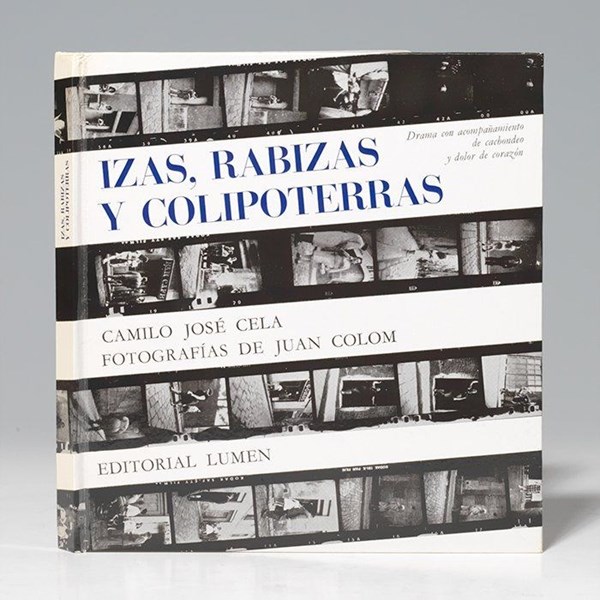
Izas, Rabizas y Colipoterras: Drama con acompañamiento de
cachondeo y dolor de corazón, 1964, Joan Colom Altemir (Photography) and Camilo José Cela (Text)
The book containing Joan Colom's photographs was the sixth to be published, in 1964, as I mentioned before. The strange and truculent title, Izas, rabizas y colipoterras was coined by the author of the text, Camilo José Cela, already a famous writer at that time. Today the book is received in the opposite way in which it was sold at the time since, for us, it is Cela who accompanies Colom, but at the time the main author was Cela, and Colom's photographs were the accompaniment to illustrate a text, which presented itself as a treatise on various kinds of prostitute.
While the list of writers was very varied, only Cela and Delibes repeated, each of them wriring two books for the collection, which contained nineteen books in total. The photographers during the first years, up to 1967, were almost always the same. Masats appeared in two (1962, 1964), Maspons in three (two in 1963 and a third in 1967), Ubiña in two (1963, 1967) and only in one, Colom (1964), Ontañón (1965) and Miserachs (1967). The series concluded with publications by Català-Roca (1968), Gasparini (1970), Malet (1970) and Colita (1971, 1975). The collection underwent a change after 1968 when Oscar Tusquets disassociated himself from Lumen to found, together with Beatriz de Moura, his own publishing company, Tusquets.
It is interesting to analyse the content of the first six titles of the collection and the order in which they appeared since, taken together, they provide a gauge with which to asses the events in Spain at the time. The series opened, very significantly, with a title by Ana María Matute, an author known for her books for children and young people, and a close friend of Esther Tusquets. The second book (Aldecoa / Masats) was devoted to boxing. The third (Cela / Maspons / Ubiña) to toreo de salón, or bullfighting classes. The fourth (Delibes / Maspons) to hunting. The fifth was devoted to traditional life in Castilla la Vieja (Delibes / Masats) and the sixth (Cela / Colom), to prostitution. Children, boxing, bullfighting, hunting, rural life, prostitutes. Up to the sixth book the subject matter could not have run into problems with the censor and, furthermore, the books were sure to be, if not a guaranteed success, at least relatively well received.
II.
That this highly original series of books commenced in 1961 is no coincidence. And perhaps it is no coincidence either that Izas rabizas y colipoterras was published in the mid-sixties. They provide a broad view of what was happening in Spain at the time, without intending to be exhaustive. During the first half of the 1950s the reigning economic policy was autarky and the country was closed off to the exterior, although the first signs could be discerned of change imposed by the internal needs of the regime. People still had ration cards until 1952 and in the collective memory the hunger and cold of the 1940 was ever present. The ration cards were a visible manifestation of the fear that dominated the post-war decade, which had commenced with brutal repression. The year 1953 is significant because agreements were signed that year with the United States that signalled the acceptance of Franco's regime by the international community and the end of autarky. This integration symbolised confidence in the long-term viability of the regime as a form of government and facilitated the entrance of foreign investment. In February 1956 confrontations took place between Falangists and students at the Complutense University in Madrid, which led Franco to dismiss Joaquín Ruiz-Giménez[2] who, as Minister of Education, had worked to end the autarky that had reigned in Spain since 1939. The new government of 1957 saw the entry of a series of ministers who were technocrats from Opus Dei. The EEC was established in 1958 and Gregorio López Bravo, at the Ministry of Industry, launched a Development Plan in 1960, preceded in 1959 by a Stabilisation Plan, intended to solve rampant inflation, worrying levels of unemployment and a high public deficit. The sudden arrival of Opus Dei on the political scene significantly changed the character of the regime which, at last, meant the adoption of new ways of doing things.
This half-open door allowed the entry of customs brought by tourists, tourism being a key factor in the modernisation of our country. The first really significant waves of tourists were in the final years of the 1950s. In 1954 a million tourists had visited Spain. In 1957 that figure was two million, reaching four million in 1960 and nineteen million in 1969. The dictatorship rejected the cultural and social changes brought about by the visiting tourists. It was not just a question of the bad example set by bikinis and short trousers. Rather it was the fact that tourists came from countries where paid holidays and other labour rights were taken for granted. This influx was accompanied by an outflow of people emigrating to other countries to find work in the industrial centres of the most developed European countries. In many cases this emigration took place in two phases. Firstly, people living in essentially rural areas, that is to say, not just Andalusia, Extremadura and Murcia, left their places of origin for the large urban centres in the centre and north of the country, forced to do so by the miserable conditions of life in the countryside. Many of them then embarked on a second migration from these cities to areas in other European countries where there was a labour shortage, and prospects for a better life were brighter. Emigration to other European countries was the last chance to escape the dire poverty of the urban peripheries where immigrants from other parts of Spain had settled.
Spain took much longer to recover the levels of economic output achieved in 1935 then other European countries. Germany and France had recovered their maximum inter-war GDP by 1948, just three years after the Second World War had ended. In our country it took until the mid-1950s, fifteen years after the end of the Spanish Civil War.
III.
Joan Colom was thirty-six years of age when he started to work on his project to depict the street life around the Ramblas in Barcelona. Five years later, in 1962, he published a selection of these photographs in the magazine AFAL. It is important to note that the photographs which Cela would later choose to include in Izas, rabizas y colipoterras are only part of a much wider and varied work. The writer rejected those that did not meet his criteria for the 'taxonomic treatment' of prostitution. On many occasions it can be seen that Cela wrote the text while looking at the photographs. The text is a paraphrase, a commentary, on them. Reading it now it seems unbearably misogynistic and contemptuous despite the fact that, according to what he said at the time, he was moved by the desire to decry a situation he thought necessary to abolish. Here, surely, lies the radical difference in the attitudes adopted by Colom and Cela. While the photographs are taken with affection and tenderness, the text does nothing but add cruelty to a situation which is, in itself, already extremely cruel. How inexplicable it would have been if Cela had written about the relations between men and women and had analysed them from a sociological perspective, or from the point of view of cultural analysis, at a time when the conceptual tools, which now seem obvious to us, were missing.
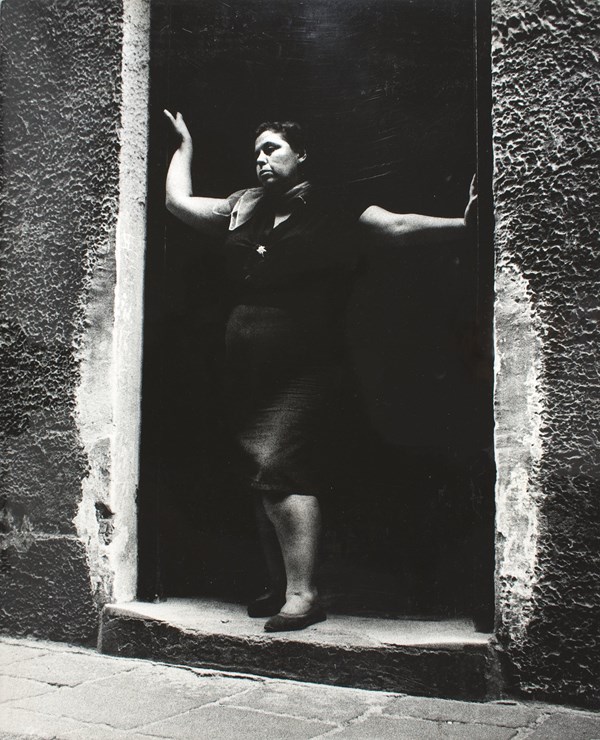
Barri Xino, Barcelona, 1960, Joan Colom Altemir
Post-war Spain, with the triumph of the most reactionary side, had receded to nineteenth-century levels of repression, as if the 1920s and 1930s had never existed. The subject of sex was taboo. It was not talked about because it had been relegated to the non-existent. We only have to remember that co-education of girls and boys had been expressly prohibited in 1939 by law, a law that remained officially in force until the end of the 1960s, although it was permitted in some private schools, such as foreign schools. The dislocation of love and sex, and the cult of the mother, exemplified the thorny subject concerning everything to do with pleasure. The lower classes, crammed into the miserable peripheries of the large cities, reacted with a frankness which had not so much to do with whatever little resistance they might have retained after having been crushed during the post-war period as with a disinhibition forced by the circumstances of extreme poverty. The prostitutes photographed by Colom in Barcelona, a port city whose Barrio Chino was almost as famous as Hamburg's Sankt Pauli, had fled the countryside, were maids who had been expelled from the houses where they served for 'licentious behaviour', or had come from the outlying, low-life districts of the large cities. The oldest amongst them were probably war widows whose only means of providing for their children was prostitution.
Sex was taboo, but the fascination felt for something that was not known about and that was, furthermore, officially prohibited, was enormous. Relations between the sexes were long, complex and difficult on account of being strictly regulated from a restrictive position so extreme as to be barely comprehensible now, a position corresponding to a highly authoritarian and hierarchical society.[3] Nevertheless, people had sex and prostitution existed, in spite of the fact that it had been 'de-officialised' at the beginning of the 1950s.
For the same reason that the issue of sex was taboo, so was everything relating to class struggle. The ugliness of the urban peripheries, their most obvious feature, was never mentioned and neither were the conditions of life in the slums. People became habituated to oppression, which seemed the norm. It was the poor who were to blame for poverty.[4] Single, middle- and upper-class ladies were ignorant of issues surrounding sex, and men of the same classes had sex with women of 'easy virtue', who were generally of humble origins.
There were, as could not be otherwise, many ways of being a woman between the two extremes of being a mother and wife, at one extreme, and a professional prostitute at the other. But a 'decent woman', one who did not wish to be mistaken for a ‘tart', had to observe official morals and follow very strict rules of behaviour which were always along the same lines: women, 'as is only right and proper', lacked initiative, were to be discreet and modest, meek and restrained. Such restrictions were made evident by the wearing of a girdle, an item of clothing that was worn well into the 1960s, and the way ladies wore their hair, which was always tightly arranged with a profusion of hair clips. It was very much frowned upon for women to wear trousers or to smoke in the street or, during the early days of a relationship, when the respective positions were still unclear, for a man to invite a woman to a drink, something that explains the question a woman would ask of a man to make clear that she was available, "Would you invite me to a drink?". I shall refer to the book by Martín Gaite, which I mentioned previously, in order to consider this more deeply, but first I would like to quote her just once to glean a little more information about these rules that made the relationship between a man and a woman 'correct'.
Torn in this thorny dichotomy between love ‘in the image and likeness of the mother' and the demands of sex, few were the lovers of the period who could know, with a minimum of precision, the kind of attraction or affinity that brought them together as a couple during their courtship. […] From the linguistic point of view, the failure of the so-called 'art of courtship' manifested itself in the malicious alteration of the meaning attributed to the [Spanish] term, 'understand someone'. It is very significant that the fact of a man and a woman understanding each other (which, in the end is what a courtship is for) should come to refer solely to sexual understanding, when this kind of understanding was, furthermore, almost never assured during the few furtive contacts allowed in a decent relationship. When it was said of a man, almost always sotto voce, “He understand so-and-so", it was clearly understood to mean that he was sleeping with her. […] Why, one asks, should a phrase that alludes to something so healthy and desirable as understanding between a man and a woman have to be vulgar, if not on account of a semantic deviation in which the term had been appropriated by the domain of prohibited satisfaction?
This linguistic trail makes it very clear that the impositions bolted into place by gender-segregated education had more than achieved their aims on a salient point: the violation of understanding.
IV.
Colom's photographs of the Barrio Chino were taken when the country was beginning to change. The time between taking the photographs, at the end of the 1950s, and the publication of the book, during the mid-1960s, is the period in which the opening up, to which I have alluded above, began to be seen in the streets and in daily life. To put it another way, Colom's book would never have been published during the late 1950s, for the same reason that the draft of the book presented to the Seix-Barral publishing house by Leopoldo Pomés around 1958, after spending a year taking photographs of Barcelona, was not published. Although Pomés and Colom's books had the same subject matter, the very sad and supremely miserable late 1950s, the difference between one and the other is clear. Colom's prostitutes bear the burden of stark and brutal sex, something that is missing in the Barcelona of Pomés.
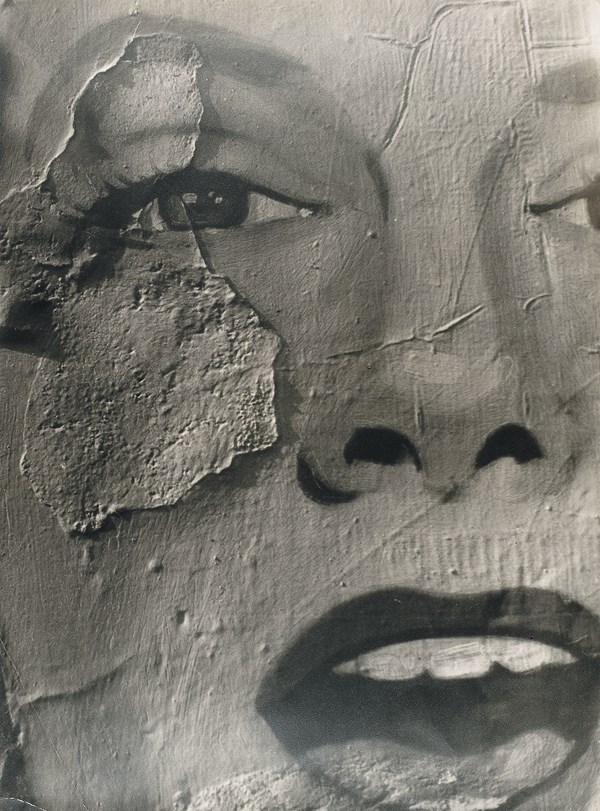
Paral·lel, 1957, Leopoldo Pomés
To complete the picture we need to include two more photographers along with Colom and Pomés. Firstly, Xavier Miserachs, whose book Barcelona Blanc y Negre was also published in 1964, and secondly, and not in Spain, Robert Frank's Les Americains / The Americans, a project undertaken during the mid-1950s in the USA, thanks to a Guggenheim grant. This book did not find a publisher in this country either and was consequently first published in France by Robert Delpire in a format that bore little resemblance to the book later published in the US, which appeared well into the 1960s.

Xavier Miserachs, 1962
V.
Knowing how Joan Colom worked enables us to better understand the reasons why we must consider him a maestro. It is as well to remember a detail that has been mentioned in many of the articles that have been published recently to mark his passing, something which many of them take as being tacitly understood: his famous technique of 'framing the picture without looking'. It goes without saying that it was essential for the people around him to be unaware of the fact that he was taking photographs and that this implied not raising the camera to his face. He could only take photographs casually, in a way that would not arouse suspicions, by looking the other way when pressing the shutter and ensuring that the film wound silently. This is so obvious that it is enough just to mention it.[5] What does require an explanation, because it really is of great importance, is that Colom practiced, without looking through the viewfinder, at predicting how the shot would turn out and at making his movements quickly, steadily and accurately in a way that would not be detected. This photographer certainly had talent, but he also worked with great determination to improve and perfect his method.
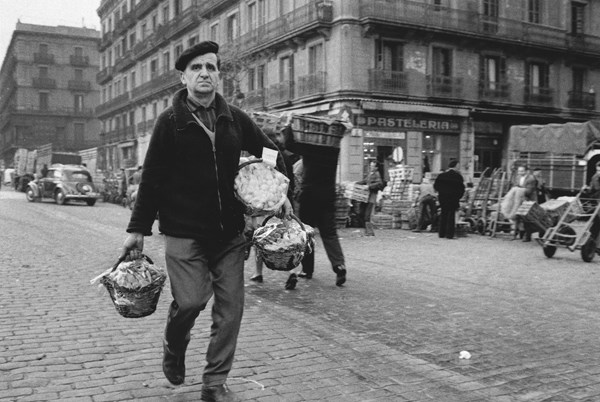
El Born, 1963, Joan Colom Altemir
Colom was able to return, day after day for years, to the same streets without arousing suspicion on account of his having developed a technique for becoming invisible. His photographs would have been very different if he had adopted the opposite technique of establishing a relationship with the prostitutes and their pimps, even if that had been possible. His practiced discretion aligns him with Cartier-Bresson, whose programmatic text on the subject of the photographer's non-intervention in the scene had appeared in the early 1950s. Cartier-Bresson is, in turn, just the opposite to William Klein, who created the photographic setting by imposing his presence on the person being photographed with no attempt to disguise the fact. It should, perhaps be borne in mind that Klein is tall and corpulent, while Colom was, in comparison, small and short. Klein found it easy to establish a relationship with his subjects whereas Colom did not and chose not to interact. While not wishing to attribute too much importance to the photographer's physique it is worth mentioning that Cartier-Bresson was a tall man who, in principle, had little chance of passing unperceived. It is also very interesting to note that Xavier Miserachs, of the same generation of photographers as Colom, chose Klein, not Cartier-Bresson, as the model to follow.
Many of Colom's photographs have a very thick grain. This is due to the fact that they were taken in very precarious lighting conditions which required the film to be 'forced', which is to say, the photograph was taken as if the film had two, four or eight times the sensitivity it actually had. Then, in the darkroom, an attempt was made to compensate for this reduced exposure by developing it more energetically. To achieve this it was exposed for a longer time, the chemicals used for developing were more concentrated, the temperature was raised, the photographic paper moved more vigorously, or all of these techniques together. The price paid for employing such a heterodox procedure, underexposing and overdeveloping, was that the quality of the photograph was not comparable to that achieved using 'normal' techniques, and the photographs lacked information in the darker areas, which appeared as stains of impenetrable blackness, and were thickly grained, making the medium itself clearly evident. This, however, was the only way of photographing movement in poor lighting, and the photograph had to be taken like this or not at all. The grain of some of the photographs in the book is especially thick because, as well as having forced the film, the photographs were severely cropped so that only a very small part of the entire image was used. The camera used by Colom, a 35 mm rangefinder Leica M2, did not have an incorporated light meter, so light readings were taken with a light meter that was either attached to it or held in the hand. The possible underexposure of certain photographs bears no relation to the fact that he did not take the photographs by looking through the viewfinder, and neither is it the consequence of a technical error. On the contrary, it demonstrates his mastery of the technique.
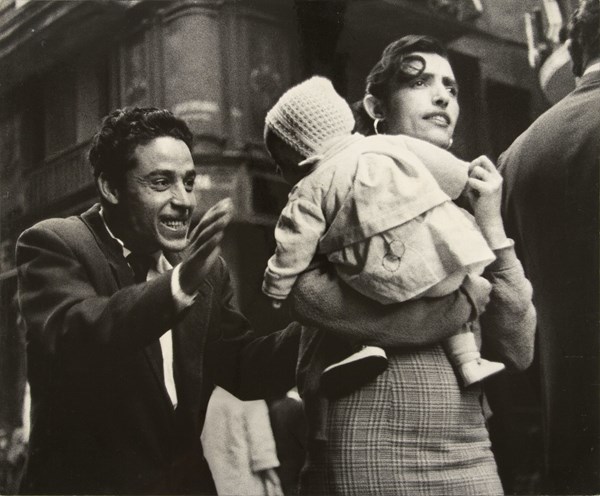
Barri Xino, Barcelona, 1960, Joan Colom Altemir
Another aspect of his work that I would like to mention is that Colom chose the photographs he wanted from the negatives as they hung, recently dried, in 1.6 m strips. He always knew exactly what he wanted and he would separate the good photographs from the rest with scissors, throwing the latter into the bin without thinking twice about it. This procedure was highly unusual, unique even, because the usual procedure was to save the entire strip of negatives in series of six. Colom, however, knew just by looking at the negatives, whether he had achieved the image he has seen in the street, without resorting to contact sheets. The entire process is like a practically uninterrupted movement that starts in the photographer's imagination as he pre-visualises the photograph, continues with the movement of his body as he releases the shutter, and concludes with the choice of the final negative. And that movement was quick because there were only a few hours between taking the photograph and choosing the negatives. Colom's modus operandi was by no means common. Normally, this last phase, the so-called second choice, would not occur as soon as the film was developed, immediately after the first choice, the one made with the camera in front of the depicted scene, but quite some time afterwards. Between the first and second choice there was usually an interruption, a break. The first choice can not be modified but the second one can, as long as all the negatives are kept. Since Colom threw the ones he was not interested in away he definitively excluded this possibility of pentimento, as a painter would say. For Colom, the second choice had the same inevitability as the first, and that is why I describe his method as a continuous, uninterrupted movement in one. The key to understanding his confidence in eliminating unsatisfactory negatives lies, perhaps, in the fact that he could only take one photograph for every scene or situation because winding the film forward would have revealed his presence. Choosing the good negatives and discarding the rest shortly after having taken the photographs and developing the film had an advantage insofar as he still had the details of the photographs he had just taken fresh in his mind.
Manolo Laguillo
Barcelona, May 2018
[1] The complete list can be consulted in Horacio Fernández (ed.), Fotos & libros. España 1905-1977, MNCARS, Madrid 2014. The article by Javier Ortiz-Echagüe on Colom's book in particular gives the details of its internal history. To this end, I have consulted the memoirs of Esther Tusquets, as well as sources contemporary with its publication.
[2] In 1963 Ruiz-Giménez founded the magazine, Cuadernos para el diálogo, which had an important influence on the style of the last phase of the Franco regime.
[3] To gain a general idea I would recommend Carmen Martín Gaite's Usos amorosos de la postguerra española, which won the XV Premio Anagrama de Ensayo in 1987.
[4] The slum area of Somorrostro, in Barcelona's Poblenou district, did not disappear until 1966, on the occasion of a visit to the city by Franco.
[5] When Colom's photographs have a very thick grain, this is due to the fact that they were taken in very precarious lighting conditions which required the film to be forced. The camera used by Colom, a 35 mm rangefinder Leica M2, did not have an incorporated light meter, so light readings were taken with a light meter that was either attached to it or held in the hand. The possible underexposure of certain photographs bears no relation to the fact that he did not take the photographs by looking through the viewfinder, and neither is it the consequence of a technical error.
